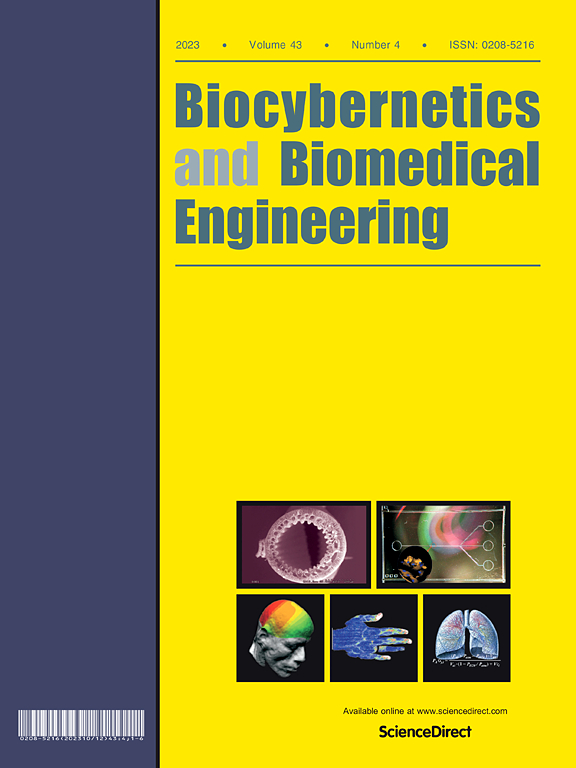节律性体育锻炼作为一种协议来研究同步现象
IF 6.6
2区 医学
Q1 ENGINEERING, BIOMEDICAL
引用次数: 0
摘要
同步现象出现在两个或多个振子的耦合过程中,在自然界和许多科学领域都经常观察到。几个节奏的情况特别有趣,因为同步可能会相互竞争。在这项工作中,我们报告了三种生物节律:心率,呼吸和运动节律之间的相位耦合的发生。我们分析了在固定自行车上逐步增加速度时它的外观。利用同步图研究同步是否存在,以检测锁相时代。研究组由21名年轻健康志愿者组成(15名女性和6名男性)。还定义了特定的亚组。在运动过程中,所有受试者的所有节律都出现同步。心脏运动同步发生的频率明显更高,这强调了相性调压反射输入对心脏携动的作用。在心脏运动同步中,我们观察到直接相位耦合(1:1)持续至少20秒。76%的受试者出现了这种情况,这表明这种类型的同步发挥了主导作用。此外,我们还观察了所有节奏同时同步出现的时代。同步运动的总持续时间在男性中明显大于女性和经验较少的骑行者。在年龄和体重指数方面没有观察到明显的差异,但是这个组是相对统一的。在运动后阶段,9名受试者出现心肺同步。由于它的频繁发生,同步是一个很好的候选的客观估计物理压力,适用于诊断,治疗和生活方式的情况。本文章由计算机程序翻译,如有差异,请以英文原文为准。
Rhythmic physical exercise as a protocol to study synchronization phenomenon
The phenomenon of synchronization, which appears during the coupling of two or more oscillators, is often observed in nature and many fields of science. The case of several rhythms is particularly interesting, as the synchronizations may compete. In this work, we report the occurrence of the phase coupling between three biological rhythms: heart rate, respiration and locomotor rhythm. We analyzed its appearance during cycling on a stationary bike with stepwise increasing speed. Presence of synchronization was investigated using the synchrogram in order to detect phase-locking epochs.
Study group consisted of 21 young healthy volunteers (15 women and 6 men). Specific subgroups were also defined.
During exercise synchronization between all rhythms appeared in all subjects. Cardiolocomotor synchronization occurred significantly more often, which underlines the role of cardiac entrainment to phasic baroreflex input. In cardiolocomotor synchronization we observed a direct phase coupling (1:1) lasting at least 20 s. It occurred in 76 % of subjects, which manifests a dominant role of this type of synchronization. Additionally, we observed subjects, in whom epochs of simultaneous synchronization of all rhythms appeared.
Total duration of synchronization was significantly larger in men than in women and in less experienced cyclists. No significant difference in age or BMI was observed, however the group was relatively uniform. During the post-exercise epoch, cardiorespiratory synchronization appeared in nine subjects. Due to its frequent occurence, synchronization is a good candidate for an objective estimator of physical stress, applicable in diagnostic, therapeutical and lifestyle scenarios.
求助全文
通过发布文献求助,成功后即可免费获取论文全文。
去求助
来源期刊

Biocybernetics and Biomedical Engineering
ENGINEERING, BIOMEDICAL-
CiteScore
16.50
自引率
6.20%
发文量
77
审稿时长
38 days
期刊介绍:
Biocybernetics and Biomedical Engineering is a quarterly journal, founded in 1981, devoted to publishing the results of original, innovative and creative research investigations in the field of Biocybernetics and biomedical engineering, which bridges mathematical, physical, chemical and engineering methods and technology to analyse physiological processes in living organisms as well as to develop methods, devices and systems used in biology and medicine, mainly in medical diagnosis, monitoring systems and therapy. The Journal''s mission is to advance scientific discovery into new or improved standards of care, and promotion a wide-ranging exchange between science and its application to humans.
 求助内容:
求助内容: 应助结果提醒方式:
应助结果提醒方式:


